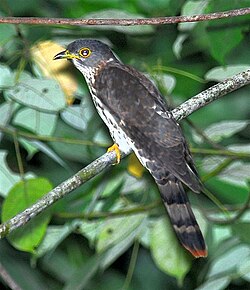| Hierococcyx | |
|---|---|
 | |
| Philippine hawk-cuckoo (Hierococcyx pectoralis) | |
| Scientific classification | |
| Kingdom: | Animalia |
| Phylum: | Chordata |
| Class: | Aves |
| Order: | Cuculiformes |
| Family: | Cuculidae |
| Genus: | Hierococcyx Müller, 1845 |
| Type species | |
| Cuculus fugax [1] Horsfield, 1821 | |
| Species | |
8, see text | |
Hierococcyx or hawk-cuckoos is a genus of birds in the family Cuculidae. They are distributed in South, Southeast, and East Asia. [2] The resemblance to hawks gives this group the generic name of hawk-cuckoos.
Contents
They are known to vocalize at their breeding grounds, making identification based on calls easy. [3]
It is sometimes included in the genus Cuculus .
The similarity of these birds to hawks gave rise to an ancient belief that cuckoos transformed themselves into hawks during the winter months, when cuckoos disappeared from Europe. [4]








